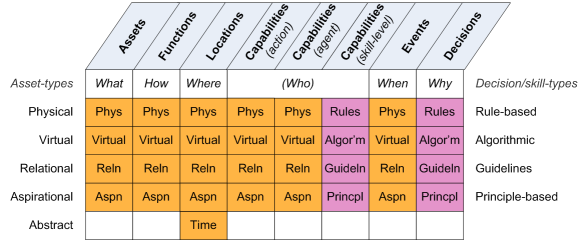Putting capabilities to use
All that discussion about capabilities – yeah, great, fine. But how do we use them? How do we use this notion of ‘capabilities’ in designing our business-models and suchlike?
I was kinda reminded about this from another direction yesterday, in a great session with Bob Marshall and others about his somewhat oddly-named ‘Antimatter Principle‘ – “attend to folk’s needs” – because that principle provides a core anchor for a structured approach to using capabilities and capability-based planning.
Three things first – or three diagrams, rather. One of these summarises the relationship between capability, function and service:
A capability is simply the ability to do something: it literally has no function until it’s placed together with a function-interface – the external interface to a service – and with the various other elements that make up and identify and drive the actual service. The ‘service-content‘ frame, from modelling with Enterprise Canvas, summarises where capabilities sit in context of all those other elements in a service:
The point here is that, for capability at least, these elements are recursive, hence we’ll expect to find variants of all of them, typically encapsulated as ‘child’-services, within each of our capabilities.
The other diagram is the ‘market-model’ or ‘service-context‘ frame, that summarises where and how the organisation and its services will sit in relation to the broader business-context:
In this sense, the organisation as a whole can be described as a service – as delivering a service, or set of services – in context of and in support of the story of the broader shared-enterprise within which it operates.
Which in turn says that, to deliver that service, or services, the organisation needs to have available to it, in some way, the respective capabilities that underpin those services.
Which brings us into the overall realm of capability-based planning – in other words, identifying what capabilities are needed, are available, and so on.
Which we could perhaps summarise overall in terms of six questions:
— What’s needed? – What is the full set of capabilities that would be needed to ‘attend to folks’ needs’ in the context of this overall shared-enterprise?
— What do we want to do? – What part do we want to play in this overall shared-enterprise? Delivering which services to this enterprise would best fit with our way of doing things, with what we value in this overall enterprise?
— What can we do? (or, equally, what can we do?) – Which of the capabilities needed for those services do we already have, or have access to, such that we already have some means to contribute to this shared-enterprise? (And hence to give us a genuine reason to be involved in the shared-enterprise, and for other actors to want us to be involved in it?)
— What could we do? – Given what we want to do, and what we can already do, what capabilities do we need to add, or change? Would we develop or acquire those capabilities ourselves, or extend or build partnerships to enable us to access those capabilities via a more indirect route? If via partnerships, how will we manage the issues around boundary of identity versus boundary of control?
— What will we do? – What commitments will we make to customers, suppliers and others in the market, and to the shared-enterprise as a whole, about what we will deliver – and hence the parameters and parameter-values for the service-level agreements that we will make? Given those commitments, how will this impact on and be dependent on the capabilities that we use to underpin those services? What will we need to do to hold ourselves to those each of those commitments?
— What won’t we do? – Given what’s needed in the enterprise, and what part we want to play within that enterprise and respective market(s), what do we not want to do in this context? Given what we can and could do, and what we will commit to do, what will we not do? What promises will we make to ourselves and others about what we will not do in our relationships in the market and the shared-enterprise? How do we make each of these choices and commitments explicit, to ourselves, and to others in the market and shared-enterprise? What will we need to do to hold ourselves to those each of those commitments?
Just some ideas to play with, anyway – any comments, anyone?



Leave a Reply